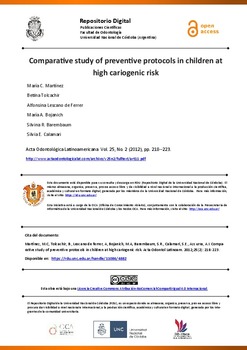| dc.contributor.author | Martínez, M. C. | |
| dc.contributor.author | Tolcachir, B. | |
| dc.contributor.author | Lescano de Ferrer, A. | |
| dc.contributor.author | Bojanich, M. A. | |
| dc.contributor.author | Barembaum, S. R. | |
| dc.contributor.author | Calamari, S. E. | |
| dc.contributor.author | Azcurra, A. I. | |
| dc.date.accessioned | 2017-08-02T13:56:03Z | |
| dc.date.available | 2017-08-02T13:56:03Z | |
| dc.date.issued | 2012 | |
| dc.identifier.citation | Martínez, M. C, Tolcachir, B., Lescano de ferrer, A, Bojanich, M. A, Barembaum, S. R., Calamari, S. E., Azcurra, A. I. Comparative study of preventive protocols in children at high cariogenic risk. Acta Odontol Latinoam. 2012;25(2): 218-223. | es |
| dc.identifier.issn | 0326-4815 | |
| dc.identifier.uri | http://hdl.handle.net/11086/4882 | |
| dc.description.abstract | The aim of this study was to compare the efficacy of two preventive protocols - fluoride gel (F) alone or combined with chlorhexidine varnishes (CHX) - on sialochemical, clinical and microbiological parameters in a group of children at high cariogenic risk. Two therapeutic-preventive protocols were applied in 73 children at high cariogenic risk (average age 6.2±1.4 years old) and clinical parameters (simplified oral hygiene index: OHIS; decayed, missing and filled teeth: dmf index; sugar intake and exposure to fluoride), as well as sialochemical parameters (salivary pH and flow, buffer capacity) and microbiological
parameters (CFU/mg of dental biofilm of Streptococcus mutans group) were recorded and correlated before and after the protocols. Association was found between parameters that cause deficient control of dental biofilm: high values of OHIS index,
CFU/mg dental biofilm, sugar intake and the d component of dmft index, and lower values of salivary flow rate and buffer
capacity. After the protocols, a significant decrease was found in OHI-S and CFU/mg dental biofilm. No significant difference
was found with children’s gender and age. The association observed between OHI-S and cariogenic bacteria
emphasizes the importance of prevention, especially regarding the oral health of the most vulnerable children. The early inclusion of F associated with CHX in the initial step of preventive and therapeutic protocols would provide benefits regarding oral microbe control while children acquire new habits of oral hygiene. | es |
| dc.language.iso | eng | es |
| dc.publisher | Acta Odontológica Latinoamericana | es |
| dc.rights | Atribución-NoComercial-CompartirIgual 4.0 Internacional | * |
| dc.rights.uri | http://creativecommons.org/licenses/by-nc-sa/4.0/ | * |
| dc.subject | Dental caries susceptibility | es |
| dc.subject | Child | es |
| dc.subject | Saliva | es |
| dc.subject | Fluorides | es |
| dc.subject | Chlorhexidine | es |
| dc.title | Comparative study of preventive protocols in children at high cariogenic risk | es |
| dc.type | article | es |
| dc.description.version | publishedVersion | es |





